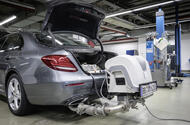Volkswagen, BMW and Daimler used caged monkeys in ‘diesel fume test’

German car makers have admitted an organisation of theirs used monkeys in diesel fume testsGerman manufacturers admit to financing study that was designed to prove emissions were lower by forcing animals to breathe in exhaust fumes
Volkswagen, BMW and Daimler have admitted to funding an emissions test that forced caged monkeys to breathe in exhaust fumes.
The study, which used monkeys distracted by cartoons in a closed environment, was designed to illustrate that modern diesel cars are far cleaner than their predecessors and not harmful to health. It took place in New Mexico, US, in 2014 but a report of the findings was never completed.
According to The New York Times, the test was handled by the European Research Group on Environment and Health in the Transport Sector (EUGT), which was an organisation established by the trio of German car manufacturers along with parts supplier Bosch. The EUGT folded before the results of the test could be compiled.
Is it time to give up on the diesel engine?
Since the nature of the test came to light, all of the involved brands have distanced themselves from it.
Daimler stated that it is “appalled by the extent of the studies and their implementation”, while Volkswagen chairman Hans Dieter Pötsch said the tests were "totally incomprehensible" and that the incident must be "investigated fully and unconditionally”.
Reports suggest other tests were carried out with humans prior to the monkey test, but that they involved inhalation of nitrogen dioxide (NO2), which is commonly associated with diesel engines, rather than exhaust fumes.
Steffen Seibert, spokesman for German chancellor Angela Merkel said that "these tests on monkeys or even humans cannot be justified ethically in any way".
In the year that followed the monkey fumes test, Volkswagen’s use of emissions cheating devices was brought to light. The Dieselgate scandal has since led to changes to regulatory emissions tests, helping to create the new Real Driving Emissions tests.
More content:
Comments
Post a Comment